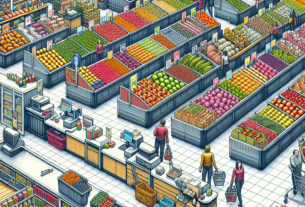The Future of Foodservice in a Gig Economy
The State of the Foodservice Industry
The foodservice industry has undergone significant changes in recent years, driven by evolving consumer preferences and technological advancements. In 2025, the industry is expected to continue to transform, with a particular focus on adapting to the gig economy. The gig economy, characterized by short-term contracts or freelance work as opposed to permanent jobs, has had a profound impact on various industries, including foodservice.
Current Trends in the Foodservice Industry
One of the key trends in the foodservice industry is the rise of food delivery services. Companies like Uber Eats, DoorDash, and Grubhub have revolutionized the way consumers access food, making it easier than ever to order meals from their favorite restaurants. This trend has only accelerated in the wake of the COVID-19 pandemic, as more consumers opt for the convenience and safety of food delivery.
Another trend in the foodservice industry is the increasing demand for healthier options. Consumers are becoming more conscious of their dietary choices and are seeking out restaurants that offer nutritious and fresh meals. This has led to a rise in plant-based and organic options on menus, as well as a greater emphasis on transparency and sustainability in sourcing ingredients.
Challenges Facing the Foodservice Industry
Despite the opportunities presented by the gig economy, the foodservice industry also faces several challenges. One of the primary challenges is labor shortages. With the rise of the gig economy, many workers are opting for freelance or temporary work over traditional employment. This has made it difficult for restaurants to find and retain qualified staff, leading to increased turnover and operational challenges.
Another challenge facing the foodservice industry is rising costs. Inflation, supply chain disruptions, and increased competition have all contributed to higher operating expenses for restaurants. This has put pressure on profit margins, forcing many establishments to raise prices or find other ways to cut costs.
The Impact of the Gig Economy on Foodservice
The gig economy has had a profound impact on the foodservice industry, reshaping the way restaurants operate and interact with customers. One of the key ways in which the gig economy has influenced foodservice is through the rise of food delivery platforms. These platforms have provided restaurants with a new revenue stream and expanded their reach to customers who may not have otherwise dined at their establishments.
Additionally, the gig economy has changed the way restaurants hire and manage staff. Many restaurants now rely on gig workers to fill temporary or part-time positions, allowing them to scale their workforce up or down based on demand. This flexibility has been especially valuable during peak hours or busy seasons when restaurants need additional help.
Financial Impact of the Gig Economy on Foodservice
The financial impact of the gig economy on foodservice has been mixed. While food delivery platforms have provided restaurants with new revenue streams, they also come with additional costs. Restaurants must pay commissions to these platforms for each order, which can eat into their profit margins. Additionally, the gig economy has made it more challenging for restaurants to predict labor costs and manage staffing levels effectively.
Despite these challenges, many restaurants have found ways to leverage the gig economy to their advantage. Some establishments have partnered with gig workers to provide catering services or pop-up events, expanding their reach and generating additional income. Others have used gig workers to fill temporary positions during busy periods, helping them to meet customer demand without committing to long-term employment contracts.
Future Plans and Innovations in Foodservice
Looking ahead, the foodservice industry is expected to continue to innovate and adapt to the challenges and opportunities presented by the gig economy. One of the key areas of focus for restaurants is technology. Many establishments are investing in digital ordering systems, mobile payment options, and loyalty programs to enhance the customer experience and streamline operations.
Another area of innovation in foodservice is sustainability. With consumers becoming more conscious of their environmental impact, restaurants are increasingly offering eco-friendly packaging, reducing food waste, and sourcing ingredients locally. These initiatives not only appeal to environmentally conscious consumers but also help restaurants reduce costs and improve their bottom line.
Market Share and Volumes in the Foodservice Industry
The foodservice industry is a massive market, with billions of dollars in revenue generated each year. In 2025, the industry is expected to continue to grow, driven by factors such as population growth, changing consumer preferences, and technological advancements. While traditional sit-down restaurants still dominate the market, food delivery services and ghost kitchens are gaining traction and capturing a larger share of consumer spending.
In terms of market share, food delivery platforms like Uber Eats and DoorDash have seen significant growth in recent years, capturing a sizable portion of the market. These platforms have become indispensable for many restaurants, providing them with access to a broader customer base and helping them increase sales. As a result, traditional brick-and-mortar restaurants are facing increased competition and pressure to adapt to the changing landscape of the industry.
Future Opportunities in the Foodservice Industry
Despite the challenges facing the foodservice industry, there are plenty of opportunities for growth and innovation. One of the key opportunities lies in leveraging data and analytics to understand consumer preferences and behavior better. By collecting and analyzing data on customer orders, feedback, and demographics, restaurants can tailor their menus, marketing campaigns, and operations to meet the needs of their target audience.
Another opportunity for restaurants in the gig economy is to diversify their revenue streams. In addition to offering dine-in and takeout options, restaurants can explore catering services, meal kits, and virtual cooking classes to generate additional income. By expanding their offerings and reaching new customer segments, restaurants can increase their market share and position themselves for long-term success.
Conclusion
In conclusion, the future of foodservice in a gig economy is full of challenges and opportunities. The gig economy has reshaped the way restaurants operate, from hiring staff to reaching customers, and has forced establishments to adapt to new ways of doing business. While the industry faces labor shortages, rising costs, and increased competition, there are plenty of opportunities for growth and innovation for those willing to embrace change and leverage technology. By focusing on customer preferences, sustainability, and data-driven decision-making, restaurants can thrive in the evolving landscape of the foodservice industry.



